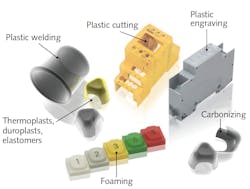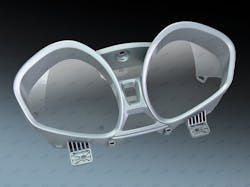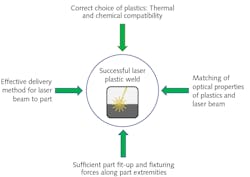Why laser plastic welding?
Laser-based welding has important advantages for plastics versus conventional contact methods. Laser welding is a non-contact process at the point of welding that generally takes place at the interface of overlapped parts and thus the weld zone is encapsulated. This results in an aesthetically pleasing weld, which is sterile and does not contaminate the surface of the parts being welded. It seems a little counterintuitive that parts already in contact with each other can be welded together, from the top down, without disturbance to their outer surfaces. With conventional plastic welding techniques such as ultrasonic or hot stamping, contact with the outer surfaces of the parts to be welded together is inevitable. Non-contact laser plastic welding works on the principle of partial transmission, reflection, scattering and absorption of laser light within the polymer chains being joined. By careful selection of the plastics and lasers optical properties, sufficient heat is generated at targeted locations to melt and fuse the materials together.
The design of a laser welding processes should be established early in product development. Attempting to retrofit a laser welding process onto previously designed plastic products, not originally designed for laser welding, can work sometimes. However, adopting design for laser manufacture principles at an early stage of plastic product development will greatly reduce manufacturability issues later.
Design considerations
Plastic products have mechanical, geometrical, thermal, and optical properties, among others (see Fig. 3). At a fundamental level, the laser weldability of plastic assemblies can broadly be determined by:
1. Are the materials chosen compatible? Compatibility refers to the melting temperatures, chemical, mechanical, geometrical, and optical properties of both plastic parts to be welded.
2. Can the laser beam be transmitted through the top layer material efficiently to reach the joint interface, and can the bottom layer material absorb the laser beam to create heat where it’s needed?
3. Can the parts be held together properly during the welding process, and can the force applied be controlled? Does the geometry of the parts result in a good fit-up between the parts without gaps between them?
4. Can the laser beam be delivered to the parts to distribute and control the heat in an effective manner, given the geometry?Thermal and chemical compatibility
Plastics melt and decompose at much lower temperatures than metals. Typical melting temperatures of engineering plastics are around 250°C. There are some plastics with much higher melting temperatures—for example, polyether ether ketone (PEEK), which is in the 350°–400°C range. Close compatibility of melting temperatures will assist mixing of the weld pool and improve mechanical strength on re-solidification. Certain combinations of plastics relatively closely matched on melting temperature are good candidates for plastic welding. The chemical composition of the plastic is also a factor. For example, it is not successful to weld high-density polyethylene (HDPE) to polypropylene (PP), but it is possible to weld low-density polyethylene (LDPE) to PP, even though PEs are within the same family. Careful consideration must be given to the material combinations.
Matching of optical properties
Lasers in materials processing generally emit a coherent and focusable light beam, at one wavelength or a very narrow wavelength bandwidth. Near-infrared and infrared wavelengths are most widely used in plastics welding from 800 nm to 2 µm. These wavelengths are longer than wavelengths visible to the human eye such as green, which is 532 nm in the visible spectrum, and red, which is 635 nm. Using the 800–2000 nm wavelengths, the plastics to be welded must exhibit some degree of transmission and absorption in this range.
Plastics are to some degree semicrystalline structures and have amorphous and crystalline phases. Differences in the refractive index between the amorphous and crystalline phases within a plastic cause light scattering and reflection when a laser beam impinges on them, in addition to the necessary transmission and absorption. This can be beneficial or a hindrance for laser welding, depending on the level of these effects. Design combinations of these properties help to achieve transmission of the laser beam through the top plastic part and absorption in the lower part (see Fig. 4). Sometimes, additives are included in the production of the polymers in the master batch to make them absorb laser light. It should be considered at the design stage whether additives are acceptable in the product—for example, would they pass FDA approval in the case of a medical device plastic?The level of glass fibers in certain plastics such as polyamide (PA-66), commonly referred to as nylon, can affect the transmission of light through them, especially at higher levels of glass fiber concentration where transmission is lower. A frequent question regarding plastics is, which colors can be welded together? There is no simple answer—many combinations are possible, even same-color materials such as clear-to-clear, white-to-white, and black-to-black can be joined with careful design of the composition. Even though visible light does not transmit colored plastics, this can be completely opposite for a single laser wavelength.
Part fit-up and fixturing
Designers must always seek to ensure that the parts are molded in geometries that lend themselves to laser plastic welding through good fit-up of the assembly components, and that the joint is accessible. Laser welding is not good at transmitting heat across air gaps and it is important that the component parts of a joint should be in contact. Lap weld configurations achieve this. Butt welds are possible in some instances and depend heavily on how the laser beam is applied to the weld seam, and on the part tolerances coming off the molding machine producing the plastic parts. Welding lids to containers is an example of good part fit-up.
Downward force during the welding process is essential for certain complex parts, especially large ones that are difficult to achieve good fit-up naturally all the way around their boundaries. The clamping force can be generated by servo drives, or through the use of pneumatic clamping. There is a collapse force for plastic welding, which governs how much force the hot and melting plastic can withstand before it starts to significantly deform, and how much force is necessary to push the parts together when molten. Often, force-displacement sensors are integrated into laser plastic welding tooling to monitor and control the force applied to the components during the welding cycle.
Effective control of heat
There are several methods for laser beam delivery to the workpiece in laser welding. The use of cartesian axes systems where there is a relative movement between a fixed laser plastic welding head and an XYZR table motion system is one example. These devices may not result in a uniform heating of large parts due to the acceleration required at start and stop points, and around changes of direction. However, this method is flexible as the laser path can be generated through CAD data. The use of high-speed galvo scanning heads allows extremely fast movement of the laser beam, at up to 10 m/s. Scanning around a weld seam at very high speed and with sufficient power allows an almost-instantaneous heating of the entire welding seam from one end to the other. This reduces the effects of simultaneous heating and cooling that cartesian axes systems create.
Another less flexible method is to laser-illuminate the parts through a mask. In this case, the mask aperture takes the shape of the required welded seam, but must be manufactured each time there is a change of design.
Occasionally, specialized laser lenses are employed that yield a line focus to provide a stitch weld along a defined length. Controlling the optical power may be required during the process, which can also be achieved with pyrometers measuring the workpiece temperature during welding and feeding this information back to a power control loop in the laser controller.
Summary
This article explains some of the basic considerations that must be taken into account for successful laser welding of plastics. Most importantly, the product itself must be designed with laser welding in mind—that’s why product design and process development teams should adopt a collaborative approach early in the product design and development phases with their customers, recognizing the aforementioned points. The mold tools for producing complex plastic products are very expensive to manufacture, and tool designers must be aware of design for manufacture issues around laser welding before finalizing a mold tool design. This will ensure that the part geometries coming off the mold tools can be subsequently laser-welded.
The uptake of laser plastic welding in industry is impressive, with diverse high-volume products from automotive light assemblies to ink-jet printer cartridges that are routinely laser plastic-welded.



